Arbaciidae
Gray, 1855, p.157
nomen corrigendum Gregory, 1900, p.307 pro Arbaciadae Gray, 1855
Genre type : Arbacia Gray, 1835, p.58
Description succinte de la famille : Apex dicyclique. Ambulacres au moins partiellement composés de plaques majeures avec une primaire centrale en forme de raquette, encadrée verticalement par deux demi-plaques. Tubercules primaires perforés, non crénelés.

|
Arbacia. Gray, 1835. Proc. Zool. Soc. London, p.58 Type-pecies, Cidaris pustulosa Leske, 1778. Add. Klein, p.85 Tertiary (?) and Recent Arbaciadae. There seem to be only five valid species of this genus, although Lovén, in his revision of it in 1887, recognized double that number. Lovén, however, considered as a good subgeneric character, one which we find cannot be relied on even to distinguish a given species, namely, the extent to which the abactinal interradial areas are free from spines, and he recognized individual differences such as the form of the test as valid specific characters. We are entirelyunable to find any character which will distinguish specimens from Brazil from those taken in the Mediterranean, while Lovén considered them as two quite distinct species. It is possible that further material from the west coast of Africa will make the recognition of the species africana Troschel desirable, and there is also a possibility that alternans Troschel may ultimately be separable from Dufresnii Bl., but in the light of such material as is now available either in the M. C. Z.. or elsewhere, these three names seem to be synonyms. The species which we recognize are lixula Linn. (including pustulosa Leske, aequituberculata Bl. and australis Trosch.), from the tropical Atlantic, ranging from the Mediterranean and Gulf of Guinea to Brazil ; Dufrenii Bl. (including africana and alternans of Troschel), from southern South America, Tristan d'Acunha, and West Africa ; punctulata Lamk., from the east coast of the United States and Mexico ; spatuligera Val. (including grandiosa Val.), from Peru and Chili ; and stellata Bl., from the west coast of Mexico and Central America. All these species are distinctly littoral, rarely occuring in depths exceeding 100 fathoms. |
In distinguishing the species of this genus, we find that no reliance can be placed on the extent to which the interambulacra are covered by the primary spines. Nor is this even an age character, for specimens of the smae size, of punctulata from Woods Hole and Newport, reveal the most striking differences in this particular. The relation of the oculars to the periproct, the number of primary tubercles on each coronal plate at the ambitus, the sculpturing of the epistroma, and even, to some extent, the color and size, appear to furnish the best characters by which the species are to be distinguished. The following table shows the characters revealed by the species we recognize. table after Agassiz, Hawaiian and other Pacific Echini, p.68 |
![]()
|
arbacia crenulata Kier, new species Plate 1, figures 1-5 ; text figures 3-4 Diagnosis.—Species characterized by crenulated ornamentation on plates. Material.—Thirty-one specimens most of which are extremely well preserved with all the ornamentation visible. Shape.—Medium size, varying from a horizontal diameter of 11.8 to 42.0 mm; moderately high, with height 40 to 50 percent of diameter, height-diameter ratio constant throughout growth (text fig. 3). Apical system.—Preserved in 21 specimens ; all oculars exsert in all specimens (text fig. 4) ; oculars generally pentagonal, small usually without tubercles; genital plates Large with genital pore in center of each plate; periproct eIongate diagonally from interambulacra 3 to 1, at greatest width between 13 to 17 percent of horizontal diameter of test. Ambulacra.—At ambitus one-half width of interambulacra ; poriferous zones straight from apical system to near margin, arcuate around large tubercles at margin, greatly widened adorally ; adorally tubercles so large that pore pairs perforate bosses; ambulacral plates compound, trigeminate ; in each poriferous zone 35 pore-pairs in specimen 13.8 mm in diameter, 42 in specimen 19.7 mm in diameter, 56 in specimen 30 mm in diameter; the number of primary tubercles in each ambulacrum varies from 7 in a specimen 11.8 mm in diameter to 20 in a specimen 33 mm in diameter ; one large pit in each ambulacrum near peristome (pl. 1, fig. 4) ; primary tubercles very large adorally, but greatly reduced in size and number to ambitus. Interambulacra.—Plates low, 22 in interambulacrum of specimen 13.8 mm in diameter, 24 in specimen 19.7 mm in diameter, 28 in specimen 30 mm in diameter ; primary tubercles very small in area extending from apical system to slightly above ambitus, no tubercles in median region, one tubercle on each plate near adradial suture, in some specimens tubercles stnaller on every other plate in some series ; tubercles very large in area from slightly above ambitus to peristome ; usually two tubercles on each plate. Peristome.—Very large, one-half as wide as horizontal diameter of test, pentagonal, relative size of peristome constant throughout adult growth (text fig. 5) ; gill slits wide, continuing considerable distance on surface of test (pl. 1, fig. 4) ; auricles high, slender, not j oined. Periproct.—Opening elongated along line passing through interambulacra 1 and 3; size constant throughout growth (text fig. 6). Tuberculation.—Ail primary tubercles imperforate, smooth, on highly inflated bosses ; surface of ail plates, where tubercles do not occur, crenulated with series of narrow grooves and ridges running from apical system to peristome (pl. 1, fig. 5). Number of tubercles relative to size constant throughout growth (text fig. 7). Comparison with other species.—This species is very similar to |
Arbacia improcera (Conrad) from the upper part of the Yorktown formation (Late Miocene). Both species have the same shape, sanie number of tubercles in the ambulacra and interambulacra, and same number of ambulacral and interambulacral plates. A. crenulata differs in the surface ornamentation of the plates. In A. crenulata the ornamentation consists of fine crenulations (pl. 1, fig. 5) that ex-tend adorally, whereas in A. improcera there are granules (pl. 1, fig. 6). Furthermore, in A. crenulata the nakul areas in the ambulacra and interambulacra extend farther adorally than in A. improcera. A. crenulata is easily distinguished from Arbacia waccainaw Cooke by its much more ventral ambitus, lower interambulacral plates, and smaller adapical tubercles. It is distinguished from Arbacia rivuli Cooke in having fewer tubercles in the adapical interambulacra. A. crenulata is similar to Arbacia sloani (Clark) from the Late Miocene (Duplin mari) but unfortunately no well preserved specimens are known of A. sloani, and it is not possible to make a detailed comparison of the two species. Occurrence.—This species is most common in the "Buckingham" facies and the barnacle–echinoid–oyster facies of the Tamiami formation. Very few specimens were collected from the typical Tamiami. Tamiami formation : Typical Tamiami : Loc. 12, 14. Tamiami formation, "Buckingham" fades : Loc. 20, 21, 22, 23, 24, 25. Tamiami formation, barnacle-echinoid-oyster fades: Loc. 26, 29, 30. Unnamed late Miocene formation : Loc. 33. Type.-Holotype, U.S.N.M. 648133, loc. 20. extract of plate 1 after Kier
|
|
Arbacia crenulata KIER,1963 - Miocène, Tamiami formation, charlotte county, floride, U.S.A., 17 mm |
![]()
|
Coelopleurus improcerus (Conrad). Plate LXXXIV, figures 4a-c Echinus improcerus Conrad, 1843, Acad. Nat. Sci. Philadelphia Proc., vol. 3, p.310. Psammechinus improcerus Stefanini, 1911, Soc. geol. italiana Boll., vol.30, p.705 Determinative characters. - Test large, circular, depressed, concave balow. Ambulacra narrow, each with two rows of primary tubercles extending from peristome over ambitus about two-thirds of way from latter to apical system, secondary tubercles above ; poriferous zones narrow, slightly flexuous. Interambulacra wide, the two rows of primary tubercles on upper surface small. Peristome large, with slight brachial incisions. Dimensions. - Diameter 35 millimeters ; height 15 millimeters. Description. - This species was first described by Conrad in 1843. No illustration accompanies the description, but the species is without doubt the form found by the authors in the Yorktown formation near the James River and Figured and described in this monograph. It corresponds in all particulars to the incomplete description which Conrad gives to it. The test is large, circular and depressed. The slope of the upper surface is very low toward the apex. The lower surface is concave. The ambulacra are narrow, each bearing to rows of primary tubercles which are much larger at the ambitus than on the lower or upper surface. They diminish rapidly in size on the upper surface and about two-thirds of the way to the apical system become secondaries or diminish altogether. One or more isolated primaries also occur at this point of disappearance with a secondary between. The poriferous zones are narrow and somewhat sinuous, the pore pairs uniserial. |
The interambulacra are broad with four rows of primary tubercles at the ambitus similar to those of the ambulacra. They become smaller, reduced in number, and more or less irregulary crowded together near the peristome. Above the ambitus the rows of primary tubercles are soon reduced to two which with diminished size continue to the apical system. A large, miliary median space is found in the upper portion of each interambulacrum. The apical system is large but much broken in the type specimen. The peristome is large with small branchial incisions. The periproct is large and elongate. Localities. - James River, near Smithfield (type) ; J. T. William's marl pit, Smith Creek, half a mile below Suffolk, Va. (figured specimen). Geologic horizon. - Yorktown formation, upper Miocene. Collection. - U. S. National Museum (166487).
Extrait de la planche LXXXIV, fig.4, d'après Clarck & Twitchell |
|
Arbacia improcera (Conrad, 1843) - Pliocène, Pinecrest beds, Sarasota, Floride, 27 mm |
![]()
|
Coelopleurus sloani Clark, n. sp. Plate LXXXIV, figures 5a-b. Determinative characters.—Test moderate size, circular, elevated. Ambulacra narrow, each with two rows of primaiy tubercles which rapidly diminish in size above the ambitus. Interambulacra with median space on upper surface without tubercles. Apical system prominent. Peristome small. Periproct large, subpentagonal. Dimensions.—Diameter 27 millimeters; height 15 milluneters. Description.—This species has a test of medium size, circular in ambital outline and much elevated. The apex is liigh and the upper surface slopes regularly and rapidly from the ambitus to it. The lower surface is concave. The ambulacra are narrow, the poriferous zones being nearly straight and flush. Each ambulacrum has two I'ows of primary tubercles imperforate and noncrenulate, which are very much larger at the ambitus than above or below. These tubercles are veiy rapidly reduced in size on the upper surface and entirely disappear or are replaced by small secondaries as the apical system is approached. The interambulacra have similar tubercles to those of the ambulacra, the two outer rows only on each area continuing to the apical system. |
The apical system is simple and distinct. The peristome is small and the periproct large and of subpentagonal outline. Related forms.—C. sloani is quite distinct from C. itnprocerus, the only other Miocene species known at the present time. It is much higher and has a quite different distribution of the primary tubercles. Locality.—Basticks Landing, Great Peedee River, S. C. Geologic horizon.—Miocene. Collection.—U. S. National Museum (166488). Extrait de la planche LXXXIV
|
|
Arbacia sloani (Clark,1915) - Pliocène moyen, Gosse Creek Fauna, Berkeley Quarry, Caroline du Sud, 23 mm |
![]()
|
Arbacia waccamaw Cooke Plate 4, figures 15-17 Test medium-sized, circular ; upper surface depressed, subconical ; lower surface evenly rounded. Periproct large, central, obliquely elongated. Oculo-genital ring dicyclic ; genital plates large, corrugated to granular, pores large ; ocular plates smaller, each with a large central tunbercle. Ambulacra with two rows of imperforate tubercles, which are large on the lower surface but are reduced to granules at the apical ends ; pore pairs three in eah plate, uniseral and straight on the upper surfac, curved around the tubercles at the ambitus, and very oblique at the peristome ; on e sphaeridial pit in each area near the peristome. Interambulacra twice as wid as the ambulacra on the upper surface, about equally wide on the lower surface because of the expansion of the proferous zones ; four rows of large imperforate tubercles on the base and ambitus, only the outer rows extending to the apex ; bare spaces covered by a shagreenlike corrugation ; plates wider than high. Peristome large, sub-pentagonal ; gill slits broad and very shallow. Diameter 34 mm ; height 17.4 mm ; diameter of peristome 17 mm. Occurence. - South Caroline : Intracoastal Waterway canal about 4.5 to 5 miles southwest of Little River (USGS 13377, type, C. W. Cooke ; USNM Accession 179251, L. C. Glenn. |
Florida : U. S. Engineers well HE 23 in southeastern Hendry County, altitude - 7 feet (USGS 18125). Type. - USNM 498888. Comparisons. - Arbacia waccamaw differs from A. punctulata in the shagreened surface of the bare interambulacra. Arbacia rivuli has no large bare areas, and its surface is coarsely granular. The upper interambulacral plates of A. improcera and A. sloani are much wider and lower. Extrait de la planche 4 |
|
Arbacia waccamaw (Cooke,1941) - Pliocène, Yorktown formation, Charlotte, Caroline du Sud, 33 mm |

|
|
Arbia and dixieus, two new genera of echinoids (Alabama and Florida), Journal of Paleontology, vol.22, n°5, p.606 Espèce type Coelopleurus aldrichi Clark, 1915 (désignation originale), U.S. Geol. Survey Mon. 54, p.158, pl. 73, fig. 6a-b et 7a-c. Extension stratigraphique (bibliographique, non vérifiée) : Oligocène sup. - Miocène inf. |
|
Genus ARBIA Cooke Arbia Cooke, 1948, Jour. Paleontology, v. 22, no. 5, p. 606. Arbia Cooke. Mortensen, 1951, Monograph of the Echinoidea, v. 5, pt. 2, p. 558. Type species, Coelopleurus aldrichi Clark, by original designation. Apical system probably dicyclic, pentagonal, encircling the periproct. Ambulacra narrower than the interambulacra throughout ; poriferous zones uniserial, the zygopores forming a straight line above the ambitus, arranged in slightly oblique groups of three at and below it, not at all expanded at the peristome; zygopores one to each plate near the apex, three to each compound plate below; without sphaeridial pits. Tubercles imperforate, more abundant below the ambitus. Peristome small, circular, moderately notched. |
Arbia bears a superficial resemblance to Coelopleurus and Arbacia, from both of which it differs in the presence of simple plates in the upper part of the ambulacra, in the total lack of sphaeridial pits (Arbacia has one, Coelopleurus several), and in the smaller peristome. From Arbacia it differs further in the narrowness of its poriferous zones at the peristome. The bare medial interambulacral areas of Arbia aldrichi, which are flush with the lateral parts, contrast with the sunken areas of Coelopleurus. The pattern of decoration is more suggestive of Arbacia. |
![]()
|
Coelopleurus aldrichi Clark,
n. sp.
|
The several specimens examined are much broken and the surfaces much
worn. Extrait de la planche LXXIII
|
|
Arbia aldrichi (Clark) Plate 3, figures 15-17
Horizontal outline subpentagonal, upper surface moderately inflated, lower surface gently rounded. Apical system pentagonal, rather large, with at least three ocular plates exsert (other oculars not preserved) ; ocular plates carrying two or three small tubercles; genital plates bearing a fine of small tubercles beside the periproct. Ambulacra narrow, regularly expanding to the ambitus; apical part composed of simple plates, each carrying one zygopore, remainder composed of compound plates, each with three zygopores; poriferous zones uniserial, nearly straight, the groups of three zygopores only slightly oblique on and below the ambitus, not at all expanded at the peristome. Interambulacra about twice as wide as ambulacra; plates about twice as wide as high. Primary tubercles rather small, evenly graded in size, two continuons rows on ambulacra, four rows on base of interambulacra, only the outer rows extending to the apex. Secondary tubercles numerous except on bare parts of interambulacra. Peristome small, about one-third the horizontal diameter, circular, conspicuously notched. Horizontal diameter 36.6 mm ; height 19 mm; diameter of peristome 12.1 mm. Occurrence.-Alabama: Perdue Hill, Monroe County (USNM 559494, type, T. H. Aldrich). Mississippi : Waterfall on Patton Creék 1/4 mile above highway 45, 1.5 miles east of Waynesboro, Wayne County (USGS 14287, W. C. Mansfield and F. S. MacNell ). |
Geologic unit -Late Oligocene, Chickasawhay limestone in Alabama. Paynes Hammock sand of early Miocene age, in MississippL MacNeil referred the bed at Patton Creek to the upper Chickasawhay, which he now talla the Paynes Hammock sand. Types.-Two cotypes, USNM 559494, depoalted by Johns Hopkins University (T 104). Comparisons-Arbia aldrichi (liftera from the American species of Arbacia in the presence of simple ambnlacral plates in the apical region, in the lack of spaeridial pita, and in the narrowness of the poriferous zones near the peristome. Its peristome is much smaller than that of Coelopleurus infulatus, ita bare interambulacral areas are not at ail sunken, and Coelopleurus has several sphaeridial pifs. Extrait de la planche 3 |
|
Arbia aldrichi (Clark,1915) - Oligocène, Caroline du Nord, U.S.A., 23 mm |

|
Genre Codiopsis Agassiz, 1840 Catalogus systematicus Ectyporum Echinodermatum fossilium Musei Neocomiensis, p.13 Espèce type Codiopsis doma (Desmarest, 1825) (désignation originale) Extension stratigraphique (bibliographique, non vérifiée) : Campanien - Danien Syn.
|
|
15e Genre. Codiopsis, Agassiz, 1840 Echinus (pars), Desmarets in Defrance, 1825. Codiopsis, Agassiz, 1840. Test de taille moyenne, sub-circulaire, pentagonal, sub-hemisphérique en dessus, presque plane en dessous. Zones porifères composées à la face supérieure de pores régulièrement superposés, plus petits et déviant un peu de la ligne droite dans la région infra-marginale. Aires ambulacraires étroites, renflées. Tubercules ambulacraires et interambulacraires de petite taille, mamelonnés, imperforés, dépourvus de crénelures, sub-scrobiulés, limités à la face inférieure, où ils forment des rangées obliques et qui ne dépassent pas l'ambitus ; le surplus du test est chagriné, couvert de stries verticales, atténuées, au milieu desquelles se montrent de petites impressions circulaires plus ou moins distinctes. Quelquefois le test est couvert, en tout ou partie, de petits appendices de forme mamelonnée, plus ou moins saillants, souvent sub-granuleux, qui se détachent facilement, et paraissent tenir lieu de radioles. Nous les désignons, pour ce motif, sous le nom de mamelons radioliformes. Péristome plus ou moins développé, tantôt s'ouvrant à fleur du test, tantôt un peu enfoncé. Périprocte sub-pentagonal. Appareil apicial solide, large, sub-granuleux, garni comme le test de mamelons radioliformes. |
Rapports et différences. - Le genre Codiopsis présente un ensemble de caractères qui ne permet pas de le confondre avec aucun autre type. Les espèces dont il se compose seront toujours parfaitement reconnaissables à leur forme sub-pentagonale, à la disposition toute particulière de leurs tubercules qui ne s'élèvent jamais au-dessus de l'ambitus, surtout à leur face supérieure chagrinée, garnie de stries sub-onduleuses ou couverte de petits radioles mamalonnés d'une structure particulière, et dont la présence n'a encore été signalée chez aucun autre genre. Le genre Codiopsis est propre au terrain crétacé, et ne renferme qu'un petit nombre d'espèces ; il commence à se montrer dans les couches inférieures du terrain néocomien et s'éteint dans l'étage sénonien inf. (santonien).
|
![]()
|
Codiopsis
lehmannae
sp. nov Pl. 9, figs 1-2; Pl. 12, figs 1-3 ; fig. 23 Derivation of name. After Mrs C. Lehmann, the finder of the holotype. Types. Holotype. BMNH EE5033; pratypes (both incompIete test fragments), BMNH EE3439, EE3440. Occurence, One specimen cornes from Becl 15, section 1. Jehel Buhays, a second cornes from hed 10 (top), section 2, lebel Rawdah. The third specimen was Pound loose in the hasal scree at Jebel Rawdah, section 2,, and is almost certainly derived from the lowest few metres of the Sirrisima. Formation (beds 3-10). Description. The holotvpe is 18.3 mm in diameter and 8.2 mm in height (45% of the diameter). The two other specimens are larger, but incomplete, and by, estimation would have been around 35-40 mm in test diameter. The base is flat, the upper surface domal, and the arnbitus is very sharp and at the base. The apical dise is preserved BMNH EE3440 and EE5033, It is dicyclic and firmly fixed to the corona (PI. 12. fig. 1; Fige 23C). The periproct is oval and 1.7 mm in diarneter in the 18.3 mm diameter individual 9,3%). Ambulacra are narrow and parallel-sided above the ambitus, where they are trigeminate. Plate compounding is arbaciid in style with two demiplates (Fig, 23B). There is single calcitic pustule on each triad (PL 9, figs 1. 2). Pores are small and widely-spaced, possibly conjugate (though preservation is too poor to be certain). Below the arnbitus the pore-pairs reduce in width markedly (Fig. 23A) and the ambulacra widen in to extensive phyllodes. The pore-pairs adorally are crowded and circular in outline veith welldeveloped periporal muscle attachment areas, Compounding becomes polygeminate in a cumplex fashion (Fig. 23A) and there is a single large tubercle on each compound plate. lnterambulacral plates are geniculate at the ambitus and adoral portions bear a single primary tubercle, This arrangement creates a row of slightly downward- |
facing tubercles along the ambitus (Pl. 9, figs 1, 2). Adradial portions of these plates have fine secondary tu.herculation. Adradial to the primary tubercles and continuing adapically along the adradial margin are very large calcite pustules, These reduce in size considerably above the ambitu.s and appear tu continue adapically at least must of the way to the apical disc, The remainder of the adapical plates may have a pitted epistroma (traces are seen in BMNH EE3439), but the test is not well preserved. Remarks. There h no doubt as to the generic placement of these specimens, on account of their distinctive pustules and arbaciid-style arnbulacral compounding. Their sharp ambitus, flat base, extensive phyllodes and ambital ring of interambulacral tubercles are distinctive and are features unknown in other species. It differs from Codiopsis brunei Lambert, from the Maastrichtian of Maastricht, in being very much larger and in lacking well-developed aboral pustules, lt cornes closer ro C. disculus Peron & Gauthier (and its synonyms C. stephensoni Cooke and C. fontei Vidal) from the late Campanian/Maastrichtian of Algeria. southern Spain, Senegal, Brazil and southern U.S.A., but differs from that spccies in having, a more depressed profile, sharper arnbitus and more distinct ambital ring of large tubercles. In C. lehmannae the primary interambulacral tubereles form a peripheral row, whereas in C. disculus the tubercles form a V-shaped arrangement extending adorally. Finally, in C. lehmannae the peristome appears highly scalloped. planches 9 et 12 (extraits)
|
|
Codiopsis lehmannae SMITH,1995 - Maastrichtien, Jebel Rawdah, Oman, 11 mm coll. Joaquín Espílez |
![]()
|
N° 2589. Codiopsis Lorini, Cotteau, 1851. Pl. 1189 et 1190, fig.1-8 Codiopsis Lorini, Cotteau, Catal. méth. des Echin. néoc. du dép. de l'Yonne, Bull. Soc. des sc. hist. et nat. de l'Yonne, t. V, 287, 1851. Codiopsis Alpina, A. Gras, Catal. des corps organ. foss. du dép. de l'Isère, p.33 et 50, pl.11, fig.7, 1852. Codiopsis Lorini, Desor, Synops. des Echin. foss., p.112, 1856. Codiopsis Alpina, Desor, id., Suppl., p.446, 1858. Codiopsis Lorini, Pictet, Traité de paléont., 2e éd., t.IV, p.240, 1858. - - Cotteau et Triger, Echin. du départ. de la Sarthe, p.166, 1859. - - Leymerie et Raulin, Stat. géol. du dép. de l'Yonne, p.621, 1859. Codiopsis Lorini, Cotteau, Etudes sur les Ech. foss. du dép. de l'Yonne, t. II, p.52, pl. LII, fig.15-16, pl. LIII, fig.1-4, 1860. - - Dujardin et Hupé, Hist. nat. des zooph. Echinod., p.519, 1862. - - Cotteau, Consid. strat. et paléont. sur les Ech. de l'ét. néoc. du dép. de l'Yonne, Bull. Soc. géol. de Fance, 2e sér., t.XX, p.360, 1863. Espèce de taille petite et moyenne, sub-circulaire, quelquefois légèrement pentagonale, renflée et sub-hémisphérique en dessus, large et plane en dessous. Zones porifères droites, formées de pores simples, petits, rapprochés les uns des autres, se multipliant d'une manière sensible autour du péristome. Aires ambulacraires un peu renflées, garnies à leur partie supérieure de granules aplatis, atténués, serrés, inégaux, épars, sur lesquels s'articulent, dans certains exemplaires bien conservés, de petits appendices plus ou moins saillants, mamelonnés, radioliformes, et qui, le plus souvent, ont disparu. Au-dessous de l'ambitus et dans la région infra-marginale, se montrent de véritables tubercules fortement mamelonnés, sub-scrobiculés, formant deux rangées distinctes, au nombre de cinq à six par série dans les plus gros exemplaires. Aires interambulacraires pourvues comme les ambulacres, à la face supérieure, de granules atténués, épars, inégaux, ou de petits appedices radioliformes, et vers la base, de deux rangées obliques de tubercules identiques à ceux qui existent sur les ambulacres. L'intervalle qui sépare les granules est finement chagriné et paraît occupé soit par de petites verrues microscopiques, soit par des stries verticales sub-onduleuses, interrompues çà et là. Péristome médiocrement développé, un peu rentrant, sub-pentagonal, marqué de faibles entailles. Périprocte étroit, sub-circulaire. Appareil apicial pentagonal, légèrement saillant, pourvu de granules et de mamelons radioliformes, idntiques à ceux qui couvrent le surplus du test, souvent même plus apparents. Plaques génitales allongées, égales entre elles ; plaques ocellaires sub-triangulaires, les unes et les autres largement perforées. Hauteur, 7 millimètres ; diamètre, 10 millimètres. Var. de grande taille : hauteur, 11 millimètres ; diamètre, 16 millimètres. Var. Alpina : hauteur, 15 millimètres ; diamètre, 20 millimètres. |
Rapports et différences. - Vatiable dans sa taille, dans sa forme plus ou moins pentagonale et costulée, cette espèce sera toujours reconnaissable à sa forme carrée, à sa face supérieure renglée, coupés à angle droit versl'ambitus, à ses ambulacres étroits, garnis, comme les interambulacres, de petits granules fins, serrés, abondants, très-atténués, et vers la base, d'une double rangée de petits tubercules mamelonnés et scrobiculés, à sa face inférieure large et plane, à son péristome un peu enfoncé, à son appareil apicial saillant et granuleux. Histoire. - Nous avons fait connaître cette espèce, en 1851, sous le nom de C. Lorini. L'année suivante, Albin Gras lui a donné le nom de C. Alpina. L'exemplaire qui a servi de type à cette dernière espèce, diffère, au premier aspect, du C. Lorini, par sa taille plus forte, sa forme générale moins renflée et plus circulaire, sa face supérieure plus finement granuleuse, et dans nos Etudes sur les Echinides de l'Yonne, nous n'avions pas hésité à séparer les deux espèces. Depuis, nous avons examiné quelques exemplaires de taille plus petite, recueillis dans l'Isère, associés au C. Alpina, dont ils sont évidemment le jeune âge. L'étude de ces échantillons nous a engagé à revenir sur cette opinion et à considérer le C. Alpina comme une simple variété du C. Lorini. Localités. - Auxerre, Cheney (Yonne) ; Marolles (Aube) ; Villers-le-Lac (Doubs). Rare. Etage néocomien inf. (Valangien sup., Jaccard). Ecole des Mines (coll. Dupin), Musée d'Auxerre, Musée de Grenoble, Coll.K Jaccard, ma collection. Explication des figures. - Pl. 1189, fig.1, C. Lorini, du Musée d'Auxerre, vu de côté ; fig. 2, face sup. ; fig. 3, face inf. ; fig. 4, aire ambulacraire grossie ; fig. 5, aire interambulacraire grossie ; fig. 6, autre exemplaire garni de ses mamelons radioliformes, du Musée d'Auxerre, vu de côté ; fig. 7, face sup. ; fig. 8, figce inf. ; fig.9, autre exemplaire de grande taille, de Villers-le-Lac, de la coll. de M. Jaccard, vu de côté ; fig. 10, face sup. ; fig. 11, face inf. ; fig. 12, aire ambulacraire grossie ; fig. 13 aire interambulacraire fortement grossie ; fig. 14, plaques interambulacraires fortement grossies ; fig. 15, appareil apicial grossi. - Pl. 1190, fig. 1, autre exemplaire, var. Alpina , du terrain néocomien de l'Isère, du Musée de Grenoble, vu de côté ; fig. 2, face sup. ; fig. 3, face inf. ; fi. 4, aire ambulacraire grossie ; fig. 5, aire interambulacraire grossie ; fig. 6, appareil apicial gossi ; fig. 7, autre individu plus jeune de l'Isère, du Musée de Grnoble, vu de côté ; fig. 8, face inf.
Pl. 1189 et 1190 d'après Cotteau, Pal. fr., crétacé, tome VII |
|
Codiopsis lorini Cotteau, 1851- Aptien - Espagne, 11 mm |
|
Codiopsis lorini Cotteau, 1851- Aptien - Espagne, 15 mm |
|
Codiopsis lorini Cotteau, 1851- Aptien - Espagne, 18 mm |
|
Codiopsis lorini Cotteau, 1851- Aptien - Espagne, 19 mm |
![]()
|
9. CODIOPSIS MAJOR, Cotteau, 1879. (Fig. 15-18.) Espèce de grande taille, élevée, renflée, subhémisphérique, se rétrécissant sensiblement vers la base. Zones porifères droites, composées de pores simples, arrondis, espacés; régulièrement superposés, paraissant plus petits et se multipliant, près du péristome. Aires ambulacraires subdéprimées milieu, presque partout d'égale largeur, si ce n'est cependant près du sommet , où elles sont étroites et aiguës , présentant à la face supérieure quatre rangées assez régulières, de petits granules saillants, peu nombreux, très espacés. Deux de ces rangées sont placées de chaque côté, très-près des zones porifères. A la face inférieure, les aires ambulacraires sont pourvues de deux rangées obliques de petits tubercules saillants ; fortement mamelonnés , diminuant de volume en se rapprochant du péristome, au nombre de cinq ou six par série. Aires interambulacraires subdéprimées au milieu, notamment vers la base, garnies à la face supérieure de petits granules identiques à ceux des aires ambulacraires, très-espacés, peu abondants, paraissant disposés en séries longitudinales irrégulières, et offrant à lai base deux rangées obliques de petits tubercules saillants et fortement mamelonnés, au nombre de cinq ou six par série. Vu à la loupe, le test, comme dans tous les Codiopsis paraît couvert de petites stries subonduleuses qui lui donnent un aspect chagriné. Péristome étroit, subcirculaire, médiocrement entaillé. Périprocte assez grand, arrondi sur les bords. Appareil apical solide, à fleur du test, peu apparent, subpentagonal. — Hauteur, 31 millim. diamètre, 38 millim. |
RAPPORTS ET DIFFÉRENCE. — Cette espèce, dont M. Barrois n'a recueilli qu'un seul exemplaire un peu écrasé, nous a paru se distinguer nettement de ses congénères par sa grande taille, sa forme générale hémisphérique et renflée, ses aires ambulacraires et interambulacraires garnies de petits granules peu abondants, très-espacés, disposés en séries longitudinales assez régulières, ses tubercules inférieurs peu nombreux et formant seulement deux rangée sur chacune des aires. Loc. - Cap Prieto. - Très-rare. - Etage urgonien Pl. 1 (extrait) |
|
Codiopsis major Cotteau,1879- Aptien, Morella, Castellon, Espagne, 46 mm |
![]()
|
Codiopsis Meslei, Gauthier, 1875. Pl. VIII, fig. 14-18. Codiopsis Meslei, Cotteau, Peron et Gauthier, loc. cit., Echin. foss. de l'Algerie, p.92, fig.122-126. 1875. - - Coquand, Bull. de l'Acad. d'Hippone, p.338.1880. Diamètre, 24 mill. - Hauteur, 17 mill. - Diam. du péristome, 10 mill. Forme circulaire, renflée au pourtour, hémisphérique à la partie supérieure, plate en dessous. Appareil apical petit, mais peu visible dans notre unique exemplaire. Zones porifères légèrement déprimées, formées de pores superposés par simples paires, se multipliant près du péristome. Aitres ambulacraires relativement assez larges, égalant à l'ambitus 0,40 des aires interambulacraires. A la partie inférieure, se trouvent deux rangées de cinq ou six tubercules peu développés, imperforés, faiblement mamelonnés. Le reste de l'aire est couvert de granules serrés, très inégaux, irrégulièrement placés. Aires interambulacraires portant également deux rangées obliques de tubercules qui ne dépassent pas la face inférieure. Il y en a six par rangée. Le reste de l'aire est couvert, comme dans l'aire ambulacraire, d'une granulation serrée et très irrégulière. Péristome peu développé, n'excédant pas 0,41 du diamètre total. |
Rapports et différences. - Très voisin du Codiopsis Lorini, Cotteau, le Cod. Meslei s'en distingue par son ambitus plus arrondi, par son profil s'infléchissant plus rapidement vers le sommet, par sa granulation plus inégale et plus serrée, et enfin par sa grande taille. Aucun des exemplaires du Cod. Lorini, trouvés en Europe, même la variété de grande taille, dont A. Gras a fait le Cod. alpina, n'excède vingt millimètres de diamètre. Localité. - Teniet-Courass, au sud d'Anouel (Djebel-bou-Thaleb). - Très rare. - Etage néocomien. Collection Peron. Explication des figures. - Pl. VIII, fig. 14, Codiopsis Meslei, vu de profil ; fig. 15, face sup. ; fig. 16, face inf. ; fig. 17, sommet de l'aire ambulacraire grossi ; fig. 18, plaques interambulacraires grossies. Pl. VIII d'après Cotteau, Péron & Gauthier |
|
Codiopsis meslei Gauthier, 1875- Berriasien terminal - Valanginien basal, Maroc, 35 mm |
![]()
|
Codiopsis Senessei Lambert (nov. spec.). PI. VI, fig. 13, 15. Test mesurant 12 mm. de diamètre sur 7 de hauteur, pentagonal, hémisphérique, à base plane et grand péristome (7 mm.) faiblement entaillé. Apex dicyclique, à périprocte central, arrondi. Ambulacres étroits, à pores simples, portant à la base entre le péristome et l'ambitus deux rangs de quatre petits tubercules et en dessus des granules serrés, inégaux, disposés sans ordre, tendant seulement à se grouper en rangées verticales au bord des zones porifères. Interambulacres nus au bord du péristome et portant à la base de l'ambitus un rang unique, transverse de huit tubercules. En dessus il n'y a plus que de petits granules très serrés, dont les moins petits sont disposés en rangées transverses flexueuses. La nudité apparente de la face supérieure de ce Codiopsis ne permet de le comparer qu'au C. Arnaudi Cotteau du Turonien de la Dordogne. Le type figuré de cette espèce (Pal. franc. crét., t. VII, p. 786, pl. 1192, fig. 12, 18) se distingue toutefois par sa forme plus haute, moins pentagonale, ses ambulacres plus larges, ses rangées transverses de tubercules interambulacraires moins droites et moins régulières, sa face supérieure portant des cicatrices de tubercules granuliformes qui devaient être assez dévelo1pés, inégaux ; tandis que chez C. Senessei les tubercules granuliformes de la face supérieure très petits sont de deux sortes : les uns forment de petites rangées transverses dans les interambulacres, les autres microscopiques, très serrés, n'ont laissé après leur chute aucune cicatrice. Les deux espèces sont évidemment différentes. Cependant Cotteau, dans la Paléontologie française, avait réuni au type du Codiopsis Arnaudi d'autres petits Codiopsis du Santonien des Martigues, dont j'ai plusieurs individus sous les yeux et qui, précisément, se distinguent du type par les caractères que je viens d'indiquer. Ces individus des Martigues ne sont donc pas des C. Arnaudi, mais des C. Senessei et ils devront être réunis à ce dernier. Quant à l'individu de Cuba, figuré par Egozcue y Cia, c'est encore autre chose, C. Cia Lambert . |
Codiopsis Senessei est assez rare dans les Corbières, mais paraît s'y rencontrer à plusieurs niveaux. Il a été trouvé près de Bugarach dans le Coniacien au causse Mija et au Roc de la Rusto, puis retrouvé au N du Linas dans des couches à Hippurites resectus, enfin au N de Bugarach, au Roc de Quatre heures dans des couches que M. Senesse rapporte à 1'Angoumien supérieur. L'espèce apparue dans le Turonien supérieur a donc continué à vivre dans le Coniacien des Corbières et se serait propagée en Provence jusque dans le Santonien. Pl. VI (extrait)
|
|
Codiopsis senessei Lambert in Lambert & Valette,1934 - Santonien supérieur, Sougraigne, Aude 8 mm |

|
Genre Coelopleurus Agassiz,1840 Catalogus systematicus extyporum echinodermatum, p.12 Espèce type Coelopleurus equis Agassiz, 1840 (désignation originale) ibid, p.12 Extension stratigraphique (bibliographique, non vérifiée) : Eocène - Actuel Syn.
|
|
GENRE COELOPLEURUS, Agassiz, 1840. Cidaris (pars), Klein, 1734. Echinus (pars), Koenig, 1820 ; Des Moulins, 1837. Coelopleurus, Agassiz, 1840 ; d'Archiac, 1846 ; d'Orbigny, 1851 ; Cotteau, 1856, 1863, 1886 ; Desor, 1857 ; Pomel, 1883 ; Duncan et Sladen, 1884 Noetling, 1885. Test de taille petite et moyenne, subcirculaire, plus ou moins renflé en dessus, plan et pulviné en dessous. Zones porifères droites, un peu onduleuses, composées de pores simples ne paraissant pas se multiplier autour du péristome. Aires ambulacraires garnies de deux rangées de tubercules non crénelé et imperforés. Tubercules interambulacraires de même nature que les tubercules ambulacraires, formant au moins quatre rangées qui ne s'élèvent pas au-dessus de l'ambitus ; les deux rangées du milieu disparaissent brusquement ; les deux rangées latérales, un peu moins développées que les autres, sont remplacées par des cordelettes granuleuses plus ou moins larges, qui deviennent plus étroites au sommet et s'arrondissent autour des zones porifères. Le milieu de l'aire interambulacraire est occupé par un espace lisse, nettement limité, marqué souvent de stries obliques disposées en lacets. Péristome petit, déprimé, muni de faibles entailles. Périprocte subcirculaire entouré d'un cordon plus ou moins régulier de granules. Appareil apical bien développé ; plaques génitales pentagonales, lisses ou granuleuses, pourvues quelquefois d'un gros tubercule saillant, perforées assez près du bord ; plaques ocellaires subtriangulaires, intercalées à l'angle supérieur des plaques génitales. |
L'appareil apical, dans certaines espèces, présente un réseau pentagonal et anguleux de cordelettes granuleuses, se reliant à la partie supérieure des cordelettes interambulacraires. Les aires ambulacraires offrent souvent, à l'angle interne des plaques, des impressions plus ou moins accentuées à la face inférieure, mais qui disparaissent vers l'ambitus. Les différents sous-genres que M. Pomel a établis parmi les Coelopleurus, sous les noms de Phrissopleurus, Delbosia et Sykesia, nous paraissent reposer sur de simples différences spécifiques. Quant au genre Keraiaphorus, Michelin, il y aurait lieu de la conserver dans la méthode, si plus tard il était reconnu que ses radioles si étranges diffèrent complètement de ceux des Coelopleurus, que nous ne connaissons pas encore. Nous croyons que c'est avec raison que M. Noëtling a démembré les Baueria des Coelopleurus, mais il a eu tort, comme nous le verrons plus loin, de considérer le Coelopleurus Agassizi comme un des types du genre. Le genre Coelopleurus, tel qu'il est admis aujourd'hui, commence à se montrer à l'époque éocène ; il existe également à l'époque miocène et dans les mers actuelles.
|
![]()
|
N° 309. - Coelopleurus coronalis (Klein), d'Archiac,1853 Pl. 337. (NDLR : il s'agit en fait de la pl. 335) Espèce de taille moyenne, subcirculaire, légèrement pentagonale, plus ou moins renflée en dessus, plane en dessous, épaisse et arrondie sur les bords, concave autour du péristome. Zones porifères un peu ondulées, formées de pores simples, arrondis, rapprochés les uns des autres, ne paraissant pas se multiplier près du péristome. Trois petites plaques porifères correspondent à une plaque ambulacraire. Aires ambulacraires costulées, étroites au sommet, s'élargissant vers l'ambitus, garnies de deux rangées de tubercules saillants, lisses, imperforés, assez fortement mamelonnés, s'élevant du péristome au sommet, tout en diminuant un peu de volume à la face supérieure, au nombre de douze ou quatorze par série. Les deux rangées sont très rapprochées, et cependant laissent la place à quelques granules intermédiaires, inégaux et se glissant ça et là entre les scrobicules. A la face inférieure, vers l'angle interne des plaques ambulacraires, se montrent de petites impressions qui disparaissent avant d'arriver à l'ambitus. Aires interambulacraires assez larges, garnies de quatre rangées de tubercules de même nature et à peu près de même dimension que les tubercules ambulacraires. Les deux rangées du milieu, coposées de sept ou huit tubercules, s'élèvent un peu au-dessus de l'ambitus et disparaissent brusquement ; les deux rangées latérales sont formées de tubercules un peu moins développés, mais qui s'élèvent plus haut ; vers l'ambitus, ils s'espacent, deviennent beaucoup plus petits et ne persistent pas jusqu'au sommet. Granules intermédiaires inégaux, assez abondants entre les scrobicules, surtout dans les rangées latérales et au-dessus de l'ambitus. Zone miliaire large, déprimée, parfaitement limitée de chaque côté par les granules latéraux un peu allongés, unis entre eux et formant une bandelette distincte qui persiste jusqu'à l'appareil apical. Tout à fait lisse en apparence, la zone miliaire est occupée par des stries obliques, atténuées, visibles seulement dans les exemplaires bien conservés. Péristome subcirculaire, un peu déprimé, muni de faibles entailles. Appareil apical assez grand, superficiel, presque lisse ; plaques génitales pentagonales, perforées un peu loin du bord, la plaque madréporiforme, spongieuse au milieu, est plus grande que les autres ; plaques ocellaires bien développées, intercalées à l'angle des plaques génitales. Quelques granules se montrent çà et là, de préférence sur les plaques ocellaires et autour du périprocte, qui est irrégulièrement circulaire et entouré d'un bourrelet saillant. |
Hauteur, 14 millimètres ; diamètre, 25 millimètres. Exemplaire plus petit : hauteur, 10 millimètres ; diamètre, 20 millimètres. Rapports et différences. - Cette espèce, très anciennement connue, a servi de type au genre ; elle sera toujours facilement reconnaissable à sa forme épaisse et renflée ; à sa face inférieure plane, subcirculaire, arrondie sur les bords ; à ses zones porifères onduleuses ; à ses aires ambulacraires costulées, garnies de tubercules bien développés, depuis le péristome jusqu'au sommet, et offrant sur la face inférieure, à l'angle interne des plaques, de petites impressions bien visibles ; à ses tubercules interambulacraires s'élevant au-dessus de l'ambitus ; à sa zone miliaire paraissant à peu près lisse ; à son appareil apical superficiel, très peu granuleux, dépourvu de cordelettes triangulaires. Localités. - Biarritz (Basses-Pyrénées). Rare. Eocène supérieur. Ecole des mines de Paris, coll. Pellat, Gauthier. Localités autres que la France. - Vich (province de Catalogne). Gerona (province de Gerona) (Espagne). A l'ouest de Bagotho oro hill, au sud de Schwan, Sind (Oligocène). Explication des figures. - Pl. 335, fig. 1, C. coronalis, de Biarritz, de la coll. de M. Pellat, vu de côté ; fig. 2, face supérieure ; fig. 3, autre exemplaire, de la coll. de l'Ecole des mines, vu de côté ; fig. 4, face supérieure ; fig. 5, face inférieure ; fig. 6, aire ambulacraire, grossie ; fig. 7, plaque ambulacraire, plus fortement grossie ; fig. 8, aire interambulacraire et appareil apical, grossis.
extrait planche 335 |
|
Coelopleurus coronalis Agassiz,1848 - Eocène, Bartonien, Burb, Barcelone, Espange, 26 mm |
|
Coelopleurus coronalis Agassiz,1848 - Eocène, France, dimension maximum de la plaque 89 mm |
juvéniles trouvés en présence d'adultes. Les radioles sont en place mais les test très fragiles sont toujours déformés, parfois disloqués
|
Coelopleurus coronalis Agassiz,1848 - Eocène, Arguis, Huesca, Espagne, 17 mm |
|
Coelopleurus coronalis Agassiz,1848 - Eocène, Arguis, Huesca, Espagne, 29 mm |
|
Coelopleurus coronalis Agassiz,1848 - Eocène, Arguis, Huesca, Espagne, 27 mm |
|
Coelopleurus coronalis Agassiz,1848 - Eocène, Arguis, Huesca, Espagne, 29 mm |
|
Coelopleurus coronalis Agassiz,1848 - Lutétien, Espagne, 16 mm |
|
Coelopleurus coronalis Agassiz,1848 - Eocène, Arguis, Huesca, Espagne, 26 mm |
![]()
|
Coelopleurus granulatus n. sp.
|
|
Coelopleurus granulatus Mortensen,1934 - Actuel, Philippines. Mactan Island. Coral Point. 250 m, 29.4 mm |
![]()
|
105. Coelopleurus Isabellae Cotteau, 1892. Pl. X, fig. 11-14 Espèce de taille moyenne, subcirculaire, légèrement pentagonale, renflée, subconique eu dessus, plane en dessous, épaisse et arrondie sur les bords, concave autour du péristome. Zones porifères larges et droites à la face supérieure, plus étroites et subonduleuses à partir de l'ambitus et à la face inférieure, formées de pores presque égaux, les externes cependant un plus larges et plus transversalement ovales que les autres, ne paraissant pas se multiplier autour du péristome. Aires ambulacraires presqu'à fleur de test à la face supérieure, légèrement bombées vers l'ambitus, garnies de deux rangées de tubercules assez gros, serrés, saillants, lisses, imperforés, s'élevant du péristome au sommet, diminuant de volume à la face supérieure et disparaissant avant d'arriver au sommet, au nombre de quatorze ou quinze par série. Les deux rangées sont très rapprochées et laissent seulement la place à une rangée sinueuse et incomplète de petits granules inégaux, qui se glissent en outre çà et là entre les scrobicules. Aires interambulacraires larges, pourvues de six rangées de tubercules de même nature que ceux qui couvrent les aires ambulacraires; ces rangées ne s'élèvent pas au-dessus de l'ambitus, les deux séries du milieu, bien que parfaitement distinctes, sont un peu moins hautes et composées de tubercules moins développés. Les deux rangées externes ne disparaissent pas complètement et sont remplacées, à la face supérieure, par une série de tubercules moins gros, plus espacés, remplacés eux-mêmes par des granules atténués et formant une sorte de cordelette. Granules intermédiaires inégaux, peu abondants, si ce n'est dans la région supérieure, où ils sont serrés, atténués et groupés autour des petits tubercules sur la partie des plaques la plus rapprochée des zones porifères, et qui est séparée de la zone médiane par une carène peu apparente; cette zone médiane, paraissant lisse, est marquée en réalité de stries obliquement transverses très faibles, à peine distinctes. Péristome subcirculaire, un peu enfoncé. Périprocte grand, irrégulièrement circulaire. Appareil apical subpentagonal, lisse en apparence, offrant çà et là quelques granules effacés. Plaques génitales pentagonales, largement perforées à une petite distance du bord; la plaque madréporiforme, de même dimension que les autres, est bien visible. Plaques ocellaires subtriangulaires, égales entre elles, insérées à l'angle externe des plaques génitales (1). Hauteur, 12mm et demi; diamètre, 27mm. |
Rapports et différences. — Cette espèce a été rencontrée en Espagne, associée au C. coronalis; elle nous a paru s'en distinguer d'une manière positive par sa forme moins épaisse, moins déprimée en dessus, plus élevée au sommet; par ses pores ambulacraires plus inégaux; par ses aires ambulacraires moins saillantes et garnies, aux approches du sommet, de tubercules moins développés; par ses tubercules interambulacraires formant, vers l'ambitus et à la face inférieure, six rangées au lieu de quatre ; par sa zone médiane présentant sur les côtés une bande plus granuleuse et séparée de la zone médiane par une carène moins saillante. Nous ne connaissons qu'un seul exemplaire de cette espèce, mais il forme assurément un type bien distinct de C. coronalis. Localité. — Gurp (province de Barcelone, Espagne). Très rare. Coll. Maurice Gourdon. Explication des FIGURES. — PI. X, fig. 11, Coelopleurus Isabellae, vu de coté; fig. 12, face supérieure ; fig. 13, face inférieure ; fig. 14, portion supérieure de l'aire ambulacraire, grossie; fig. 14, portion de l'aire interambulacraire, grossie. (1) C'est par erreur que le dessinateur, fig.11, a représenté ces plaques comme aboutissant directement sur le périprocte. extrait planche X
|
|
Coelopleurus isabellae Cotteau,1892 - Lutétien, Folgueroles, près de Vic, Barcelone, Espagne, 18 mm |
|
Coelopleurus isabellae Cotteau,1892 - Lutétien, Folgueroles, près de Vic, Barcelone, Espagne, 23 mm |
![]()
|
1° Keraïaphorus Maillardi N. (pl.14). Ce genre est intermédiaire entre les Cidaris et les Hemicidaris, et nous l'avons nommé keraïaphorus (porte-corne), à cause des radioles de ses gros tubercules, qui se terminent, sur une longueur des neuf douzièmes, comme les antennes des grands capricornes (cerambix). Cet oursin, de moyenne taille, est un peu comprimé. Les ambulacres sont larges et garnis de gros tubercules dans la partie inférieure ; celle supérieure paraît presque lisse, quoiqu'elle soit ornée de très-petits tubercules miliaires en petits sillons transversaux. Les gros tubercules ambulacraires et interambulacraires sont lisses, perforés et à bs non crénelée. Les cercles scrobiculaires sont rarement complets, étants déformés par les petits tubercules des ambulacres. Le péristome est assez grand, avec des entailles peu profondes. Le périprocte, irrégulièrement arrondi, est entouré de petits tubercules, et de plaquettes ocellaires et génitales; sauf celle madréporique qui est très-poreuse, les autres présentent des dentelures semblables à des feuilles. Les radioles s'offrent, à peu près, sous trois formes différentes, savoir : Ceux des gros tubercules sont longs, de 11 à 13 centimètres, un peu courbés, triangulaires à la base, avec un côté arrondi. A compter du cinquième centimètre, les radioles s'arrondissent et se terminent en pointe. Les bases sont d'un rouge violacé, mêlé d'un vert clair un peu sale, et du moment où les radioles s'arrondissent, ils deviennent d'un blanc verdâtre, orné de taches d'un rouge plus ou moins foncé. Les radioles qui entourent le péristome sont lisses, aplatis et blancs. Un côté seulement porte des taches irrégulières d'un rouge vineux. Leur longueur atteint environ de 1 à 5 centimètres. Leur couleur est d'un rouge brique. Les pièces figurées (pl. 14), fig. 7 a à f, font partie de l'appareil manducatoire. Cette espèce rarissime a été ramenée dans les mers de Bourbon, d'une profondeur d'environ 200 mètres. Nous dédions ce bel oursin à M. Maillard, qui publie l'histoire naturelle peu connue de Bourbon. |
|
Coelopleurus maillardi (Michelin,1862) - Actuel, Philippines, 38 mm |
|
Coelopleurus maillardi (Michelin,1862) - Actuel, Cebu, Philippines, 42 mm chaluté à 200m, pêcheurs locaux |
![]()
|
Coelopleurus melitensis sp. nov. Plate 6 and text-6g. 1 Derivarion of name. After the Island of Malta (Latin: Melita). Holotype (monotype). Natural History Museum, Malta, MM/E 300. Diagnosis. On its apical dise the species has a distinctive star-shaped raised area with arrowhead-like promontories protruding into the naked bands on the inter-ambulacra. These naked areas are bordered by prominent protuberant tubercles and are decorated with zigzag grooves, striae, lateral ditches, oblique ridges, and microscopic granulations. Description. Test. Small, low hemispherical, with a somewhat flattened apical region. Oral surface mainly flat, but concave round the peristome. Peristome 5.3 mm. diameter (just under one-hall diameter of test). The presence of 3-4 sphaeridial pits along the median suture of each ambulacrum helps to distinguish the genus from Arbacia (one pit) and from Arbia (none). Test subpentagonal in outline with a maximum diameter of 10.9 mm., height 4.3 mm. The width of ambulacra at ambitus is 3.5 mm., whilst that of interambulacra at ambitus is 2 mm. Apical system. Dicyclic. The apical dise has a highly characteristic star-shaped raised area and well-developed exsert ocular plates that end in a protuberance. This raised area protrudes deeply into the naked areas on the interambulacra in the form of five arrow‑head promontories with slightly concave sides. The arrowhead shape is due to the characteristic quadrangular depression on either side of each promontory. Genital plates are large. The genital pores are five large openings aboral to the arrowhead promontory, and suggest full sexual maturity. The periproct, which is large and central, lacks a prominent ring-like edge. It is polygonal (min. diam 1.0 mm., max. diam. 1.5 mm.) and about one-tenth diameter of test. There is a circle of 10 small tubercles (0.2 mm. diam.) in the apical disc adjacent to the periproct, a feature which Duncan and Sladen state to be 'very generally present' in the genus (1885, p. 48).
Interambulacra (Pl. 6). Each interambulacrum consists of two columns of alternating plates, each plate being broader than high. The horizontal sutures are very shallow, but the longitudinal ones are deeply grooved. An additional pentagonal plate, higher than broad, is present on the interradius of one of the interambulacra at the level of the third protuberant tubercle from the apex (aip). This additional plate lacks tubercles but bas a surface decoration similar to that of neighbouring plates on the naked area. Below the ambitus, there are 14-15 tubercles in each interambulacral area, arranged in 4 longitudinal rows, with a maximum of 5 tubercles per row, and with the largest tubercles at the ambitus. Above the ambitus the outer two rows are continued by a single series of small tubercles (smt) that extend to the apical system. The inner two rows do not continue above the ambitus so that each interambulacrum has, adapically, a naked median space, on each side of which are 4-5 prominent protuberant tubercles (ppt). Unlike ambulacral tubercles, their height is greater than their width. Each interambulacral plate contains only one such prominent tubercle, to which are generally associated two of the small marginal tubercles (smt). The fourth and fifth prominent protuberant tubercles, however, are associated with 3 and 4 small marginal tubercles respectively. The naked areas are ornamented with deep grooves arranged in a zigzag (zzg), together with striations, sunken marginal areas or lateral ditches (ld), oblique ridges (or), and microscopical granulations that are larger and more conspicuous in the central region of each plate. The protuberant tubercles lie interradial to the marginal tubercles (smt) of the interambulacral areas and are totally different from them. They (ppt) are all very prominent, with the third one from the apex being most so, and the fourth one almost as large as the third. Each protuberant tubercle alternates with its counterparts on the opposite side of the naked area. The deep grooves arranged in zigzags cross the naked areas obliquely, being directed towards points just aboral to the protuberant tubercles. They do not, however, extend the whole distance across the naked area (zzg). Aboral to most of these grooves. and making an angle of about 10° with them, is a weak striation (zzg). On the interradial side of each protuberant tubercle, adjacent to the aboral part of the latter, a short, hooklike ridge or process is present. Tt gaps the sunken areas (lateral ditches) that are round at the sides of the naked interambulacra, decreasing in strength interradially untiI it finally dies out (or). The depressed longitudinal areas on the lateral sides of each naked |
interambulacrum, bounded adorally by successive lateral ridges', are herein referred to as 'laieral ditches' (ld). Comparisons. Arbacia (Pliocene to Recent) differs from Coelopleurus by being more heavily ornamented, by having only a single sphaeridial pit in each ambulacrum, by having straight pore zones (widening at peristome), in the absence of a proper naked area in the interambulacra, and by having numerous primary tubercles arranged in several horizontal and vertical se ries. Arbia (U. Oligocene to L. Miocene, U.S.A.) can be distinguished from Coelopleurus by having simple ambulacral plates, no sphaeridial pits, smaller peristome, pore zones that are in a straight line above the ambitus and raised with pore pairs forming `slightly oblique groups of three at and below it' (Cooke 1959, p. 21), and complete absence of lateral ditches which results in the median naked areas being flush with the lateral parts. Comparison with material in the British Museum (Nalural Historry) C. forbesi Archiac and Haime 1853 and C. sindensis Duncan and Sladcn 1885 are the only two other Miocene species sa far known. C. sloani Clark 1915 and C. improcerus (Conrad) Clark and Twitchell 1915, from the Miocene of the United States and originally regarded as belonging to the genus Coelopleurus, have since been transferred to Arbacia by Cooke (1941). C. forbesi, which is the most typical Coelopleurus of the Indian Miocene, has been recorded from the Middle Oligocene Lower Nari Series and from the Lower Miocene (Burdigalian) Gaj Series of Sind, West Pakistan (Duncan and Sladen 1885, p. 287). The species was refigured and redescribed by Stockley (1927) from the Lower Miocene Chake Chake Beds of the Pemba Series in East Africa. Compared with C. melitensis Stockley's specimen (E 17897) is larger and lias flatter (less inllated) and more spread out ambulacral tubercles, but it lacks the distinctive star-shapecl area on apical dise, the arrowhead promontories, the wide genital pores, and the protuberant tubercles adjacent to the naked areas. C. sindensis (E 702), from the Lower Miocene (Burdigalian) Gaj Series, W. Pakistan, though showing marked similarities to C. melitensis sp. nov., such as the band-like naked areas with prominent grooves and wide genital pores on conspicuous arrowhead promontories that protrude deeply into the bare areas, Jacks the highly characteristic star-shaped raised area on the apical dise. Both specimens in the collection have a larger size. Their diameter is 33 mm. and 20 mm. whilst their height is 16 mm. and 12 mm. respectively. (C. melitensis has a diameter of 10.9 mm. and a height of 4.3 mm.) The mare highly ornamented, conical apical region, the less prominent protuberant tubercles, and the more developed grooves of the naked area are also distinguishing features. C. coronalis (Leskc) (E 3179), from the Eocene of France, shows considerably more ambital divergence of the nakcd areas, whose marginal granules are as prominent, but whose marginal tubercles are not as protuberant as C. melitensis sp. nov. C. equis Agassiz. a subjective junior synonym of C. coronalis (Leske), (E 10982, E 10983) are from the Eocene of Biarritz, France. The specimen E 10982, which has a broken apical system, lacks supraambital swelling, and the primary interambulacral tubercles extend above the ambitus. A broken perforated tubercle has a crenulated base, a featurc usually inconsistent with Arbacioida. ln E 10983, the apical system is crushed, it has naked areas that widen up towards the ambitus, even more so than in E 10982. C. agassizi Archiac (E 75697), from the Eocene of Biarritz, has similar subpentagonal outline, but wider poriferous zone, more heavily tuberculate apex, and a more continuous (though less spread out) row of tubercles. (The abactinal surface is abraded.) C. spinosissimus Agassiz (E 38718), from the Calcaire Grossier of the Paris area, though showing close similarity in ail features, is not quite identical with C. melitensis sp. nov. of which it may well be an ancestor. Though crushed sideways its shape is more rounded. The ambulacral tubercles are more pointed and spiny looking, but less protuberant above the ambitus. The ambulacral marginal granules are more pronounced. A Recent dry specimen in the Spirit Room Collection of the Museum 6.19.104, C. maillardi (Michelin), collected from 'Station 24', from a depth of 73-200 m., is similar ta C. melitensis in smallness of size (13 mm. x 8 mm.), subpentagonal shape, outline of periproct, and band-like naked areas on the interambulacra. Major distinctions are the shape of the raised promontories, which are polygonal instead of arrowhead, due ta the absence of lateral quadrangular depressions, the presence of radiating lines round the fairly wide genital pores, the absence of the round-topped, higher-than-broad, protuberant tubercles (which are repIaced by tubercles that are only slightly more prominent than adjacent ones), and the presence of a row of small tubercles inside and parallel to the interambulacral marginal wall. The oblique ridges are straighter and longer, and, with the exception of one ridge (which covers only three-quarters of the distance), they cxtend over the whole width of the naked area. extrait planche 6
|
|
Coelopleurus melitensis Zammit Maempel,1969 - Lower Globigerina Limestone, Gozo, Malte, 13 mm |
![]()
|
N°311.- Coelopleurus paucitubertulatus, Cotteau,1892 Pl. 336, fig. 6-11. Espèce de très petite taille, renflée, circulaire, subpentagonale, déprimée en dessous. Zones porifères n peu onduleuses. Trois plaques porifères correspondent à un plaque ambulacraire. Aires ambulacraires légèrement renflées, garnies de deux rangées de petits tubercules saillants, mamelonnés, serrés, diminuant rapidement de volume à la face supérieure et près du péristome, au nombre de sept ou huit par série. Tubercules interambulacraires moins gros que les tubercules ambulacraires, peu nombreux, s'élevant à peine vers l'ambitus, saillants, serrés, assez irrégulièrement disposés, accompagnés de quelques granules épars, chaque rangée composée de trois ou quatre tubercules seulement. Les deux rangées externes sont remplacées au-dessus de l'ambitus par quelques tubercules secondaires beaucoup plus petits, espacés et formant cordelette. La zone médiane paraît lisse et présente seulement deux rangées de quatre ou cinq très petits tubercules allongés et atténués. La face inférieure offre un aspect strié dû sans doute à la disposition des petits granules qui séparent les paires de pores. Péristome subcirculaire, assez grand, enfoncé, marqué de légères entailles. Appareil apical subpentagonal, granuleux, un peu renflé autour du périprocte, présentant des cordelettes anguleuses qui se relient aux cordelettes interambulacraires. Plaques génitales pentagonales, pourvues chacune d'un tubercule fortement mamelonné. Plaques ocellaires intercalées entre les plaques génitales et n'aboutissant pas sur le périprocte. Hauteur, 2 millimètres et demi ; diamètre, 5 millimètres. Rapports et différences. - Nous ne connaissons de cette espèce qu'un seul exemplaire. Nous avions pensé d'abord à le réunir au C. Agassizi, qu'on rencontre dans la même localité et dont il nous paraissait être le très jeune âge, mais en l'étudiant et en le comparant avec soin, nous avons renoncé à cette opinion. |
Le C. Munieri se distingue du C. Agassizi par sa forme plus pentagonale ; par ses aires ambulacraires plus renflées ; par ses tubercules plus saillants ; par sa face inférieure plus finement striée sur le pourtour du péristome, et enfin par la présence, sur chacune des plaques génitales, d'un gros tubercule isolé qui fait complètement défaut chez tous les exemplaires que nous connaissons du C. Agassizi. Localité. - La Gourèpe (Basses-Pyrénées). Très rare. Eocène supérieur. Coll. Cotteau (M. Munier-Chalmas) Explication des figures. - Pl. 336, fig. 6, C. Munieri, vu de côté ; fig. 7, face supérieure ; fig. 8, face inférieure ; fig. 9, aire ambulacraire, grossie ; fig. 10, aire interambulacraire prise à la partie inférieure, grossie ; fig. 11, appareil apical, grossi. extrait planche 336
|
|
Coelopleurus munieri Cotteau,1892 - Eocène, Tarragone, Espagne, 26 mm |
![]()
|
Coelopleurus undulatus n. sp.
|
Holotype, conservé au Musée National d'Histoire Naturelle de Copenhague
|
http://echinoderms.lifedesks.org/file-colorboxed/239 spécimen ZMC ECH 337, Sagami Bay, Japan. Crédit photo Simon E. Coppard, 2010.
|
||
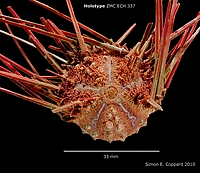 |
|
Coelopleurus undulatus Mortensen,1934 - Actuel, Philippines. Offshore Caubian Island. 300 m, 37.3 mm |
![]()
|
Sous-genre Murravechinus Philip, 1965 The tertiary echinoids of South-Eastern Australia. III Stirodonta, Aulodonta, and Camarodonta, p.3 Espèce type Murravechinus paucituberculatus (Gregory, 1890) Some additions to the Australian Tertiary Echinoidea , p.486 Extension stratigraphique (bibliographique, non vérifiée) : Miocène
|
|
Genus Murravechinus (Tate MS.) gen. nov. Murravechinus Tate MS. 1888. p. 251. Coelopleurus L. Agassiz, Gregory 1890, p. 486. Murravechinus Tate MS. 1891, p. 272. 274; 1893, p. 191. Coelopleurus L. Agassiz, Lambert and Thiry 1914, p. 264. (partirm.) Coelopleurus L. Agassiz, Mortensen 1935, p. 605 et seq. (partim.) Type species : Coelopleurus paucituberculatus Gregory 1890, p. 486-7, PL 14, fig. 4-5 (= Murravechinus spinosus Tate MS.). Diagnosis : Coelopleurus-like form in which the subambital interambulacral plates possess greatly redues primary tubercles so that each plate is ornamented with 2 or 3 small tubercles and smaller granules. The perignathic girdle consists of slender, distant auricles. Remarks: Tate (1888) originally introduced the manuscript narre Murravechinus for this handsome arbaciid, but later (1891, p. 272) wrote that this was identical with the species which had th ergbeen described by Gregory as Coelopleurus paurituberculatus. Although Gregory's original description was based on a single imperfect specimen, he note d the important distinction of this form from species of Coelopleurus, namely the absence of primary tubercles in the interambulacra. This peculiarity did not escape Mortensen (1935, p. 608-9, p. 612) in the compilation of his encyclopaedical monograph. He noted that this Australian species thus stood well apart from the other species included in Coelopleurus and 'that the species rnight rather form the type of a separate genus should it prove to be as described by Gregory. Mortensen even sought to examine the type specimen which had been lodged by Gregory in the Ipswich Museum, but found that it had been lost. Topotype material now establishes that Gregory's description was accurate in all detail. Consequently Tate's MS. name Murravechinus is here validated as a generic category to contain this single species. Mention should be made of the genus Sykesia Pomel (1883, p. 88) diagnosed as pussessing 6 series of interambulacral tubercles, which would suggest close comparison with Murravechinus. However, Sykesia was based on the figures of Coelopleurus pratti d'Archiac (d'Archiae and Haime 1853, P1. 13, fig. 5-6). The subsequent description and illustration of the species (Duncan and Sladen 1885, p. 254-257, Pl. 39, tig. 9-12) shows the interambulacra to possess two stries of large primary tubercles as in typical species of Coelopleurus. Lambert and Thiéry (1914, p. 264) note 'Les tubercules secondaires du C. Pratti résultent seulement de la restauration d'un individu très défectueux en sorte que le genre Sykesia n'a aucune valeur réelle. The excessive enlargement of the ambulacral tubercles relative to those of the interambulacra in Murravechinus leads to the arnbulacra being slightly wider than the interambulacra at the ambitus, unlike fossil species of Coelopleurus. A further outcome of this peculiarity is the fact that there are considerably more interambulacral plates than ambulacrai plates in adjacent columns. Attention may also be directed to the extremely delicate auricles of Murravechinus (Fig. 2d). In Coelopleurus the girdle, although variable, in general consists of auricles united above the arnbulacras. In Murravechinus these are verty thin processes, widely separated at their extremities. They are so delicate that they were found almost impossible to free from the soft matrix without damage. Undoubtedly Murravechinus represents a specialized offshoot from Coelopleurus wich, in middle Tertiary times, was present in India. Coelopleurus itself is represented in the living Australasian fauna by C. australis H. L. Clark, known only from Bass Strait. This is a typical species of Coelopleurus, verty closely related to the South African C. interruptus Doderlein. fig.2 c-d et f-g |
![]()
|
Gen. Coelopleurus, Ag., 1840. Coelopleurus paucituberculatus, sp. nov. Pl. XIV. Figs. 4 and 5. Test tumid; depressed abactinally ; concave below. Circular. Apical system large; ornarnented with tubercles; radials narrow. Anus slightly elliptical. Ambulacra: narrow above with small tubardes ; but wide at the ambitus with large tubardes; bath sets are uncrenulate and imperforate. The bosses are large and fill up nearly the whole of the areola. Two rows of small flat granules run up the centre of each area at the ambitus, but disappear above. Eleven plates in a vertical series. Interrambulacra.—The haro median band at the stimula of each area is bounded on either skie by a row of large, and a row of malt granules. At the ambitus the number of granules widen, and there are three rows of subequal granules on either sicle. No primary tubercles. Fifteen plates in the vertical series. Mouth large ; in a concavity. Buccal slits broad. Distribution: Middle Murravian, Morgan, S. Australia (preserved in the Ipswich Museum). Coelopleurus is a typically Cainozoic genus, but has not previously been recorded from the Australian Tertiaries. The type-specimen of the new species is broken, but the apical dise and most of the abactinal surface, a complete ambulacrum and the boives of the two adjoining interambulacra are shown ail the points in the anatomy of the test can therefore be determined. Cœlopleurus paucituberculatus is very easily distinguished from any other species of the genus by the complete absence of primary tubercules on the interradii (the character which bas suggested its Immo), and by the persistence to the apioal dise of a pair of granules on either sida of the haro median area. In the latter facture it resembles Coelopleurus sindensis, Dune. and 51., which is apparently its nearest ally. It can be easily distinguished from this by the absence in the new species of the primary arnbital interradial tubercles. planche XIV (extrait) |
|
Coelopleurus paucitubertulatus, Gregory, 1890, Some add. to the Australiae tert. Echinoidea, Geol. Magaz. Dec. III, vol. VII, n°317, p. 486, 1890. - Espèce renflée, déprimée en dessus, concave en dessous. Aires ambulacraires étroites au sommet, s'élargissant vers l'ambitus, garnies de deux rangées de tubercules assez gros et fortement mamelonnés vers l'ambitus, diminuant de volume à la face supérieure. Au milieu des aires interambulacraires, une large bande lisse médiane bordée au sommet, de chaque côté sur la face supérieure, par une double série, l'une de gros granules espacés, et l'autre de granules plus petits. Vers |
l'ambitus, ces séries sont au nombre de trois de chaque côté. Partout les granules sont lisses et imperforés. Pas de gros tubercules interambulacraires. Périprocte circulaire, entouré d'un cercle régulier de petits granules. Appareil apical largement développé ; plaques ocellaires étroites, granuleuses. Cette espèce rappelle le C. sindensis, Duncan et Sladen ; elle s'en distingue nettement, ainsi que de tous ses congénères, par l'absence de gros tubercules à la base des aires interambulacraires. Morgan. S. Australia. |
|
Coelopleurus (Murravechinus) paucituberculatus (Gregory,1890) - Miocène, Morgan Limestone, Overland Corner, Australie du Sud, 17 mm |
|
Coelopleurus (Murravechinus) paucituberculatus (Gregory,1890) - Miocène, Morgan Limestone, Australie du Sud, 15 mm |

| diagnose originale du genre par de Loriol | |||
| Notes pour servir à l'étude des échinodermes, 1884, p.606 | |||
|
|||
|
|
|||
| diagnose originale de l'espèce par de Loriol | |||
| Notes pour servir à l'étude des échinodermes, 1884, p.608 | |||
|
|||
|
NB : remarquer la structure ambulacraire : il ne s'agit pas d'une succession de pores ronds identiques, comme soutenu dans la diagnose du genre et de l'espèce. Le pore perradial est rond, mais le pore adradial est en forme de goutte d'eau horizontale, la partie pincée vers la suture perradiale. ce dernier est situé plus haut sur la plaque ambulacraire, donnant ainsi l'allure d'une disposition en équerre de ces deux pores. |
|||
|
|||
|
|||
|
|||
|
|||
|
|||
|
|
|
Gymnodiadema hessi Smiith,2011 - Bajocien, entre Enjil et Boulmane, Maroc, 56 mm |

|
Genus Hattopsis n. gen.
|
Remarks.-Because the new genus has compound trigeminate ambulacral plates of arbacioid type, this places the genus in the Arbacioida, family Arbaciidae. The type species of the new genus seems to be closely related to Codiopsis L. Agassiz in having a hemispherical or almost spherical test, with compound trigeminate ambulacral plates. There are, however, important differences: Codiopszs lacks tubercles on the adapical side, while Hattopsis has tubercles throughout the adapical and adoral sides. On the other hand, the ambulacral structure is unique among arbaciids and the stalked granules are absent in the new genus. |
![]()
|
Hattopsis spharicus n.
sp. Etymology.-From spherical, the characteristic shape of the test.
|
and slightly crenulate, with zrgzag margins; two small tubercles in each interambulacral plate at ambitus and one at base of test near peristome and above ambitus to apical system; 14 interambulacrum plates in a column at 18.4 mm test diameter and 12 at 16.2 mm. Peristome with circular outline, small to moderate size, diameter 35.442.0 percent of test diameter; gill slits shallow.
fig. 3-5 |
|
Hattopsis sphericus Ali,1992 - Maastrichtien, Jebel Buhays, Emirats Arabes Unis, 16 mm |
|
Hattopsis spericus Ali,1992 - Maastrichtien, Jebel Rawdah, Sultanat d'Oman, 14 mm coll. Joaquín Espílez |
![]()
|
Hattopsis paucituberculatus sp. nov. Pl. 9, figs 9-11 ; Pl. 10, figs 3, 6 ; Pl. 11, fig. 9 ; Figs 24, 25A, 26A, 27B Types. Holotype EE3683, paratypes, EE3682, EE3678, EE3688, EE3684-85. Material studied. There are 22 specimens in addition to the types. Biometric data is based on the following specimens : BMNH EE3672, EE3675, EE3678-79, EE3682-85, EE3688. Occurence. This species was found at the following localities and horizons : Jebal Faiyah, section 1 : bed 2 (12). Jebel Buhays section 1 : in scree derived from lowest beds of the Simsima Formation (11) ; base of bed 12 (1). Jebel Buhays, section 3 : basal beds of the Simsima Formation (2). Jebel Aqabah : bed 1 (1). Jebel Rawdah, section 2, bed 8 (1) ; loose in scree derived from lowest part of section (1). Diagnosis. A species of Hattopsis with only a single interambulacral tubercle on each interambulacral plate at all sizes. Description. Tests ar 6.2 to 18.2 mm in diameter and circular to rounded pentagonal in outline (Pl. 9, figs 9-11). Test height is 58-83% of test diameter (mean = 71%, SD = 6.7%, N = 9) and in profile the test appears globular. The apical disc is dicyclic, like that of H. spericus (Fig. 25A). It is 28-37% (mean = 31%) of test diameter in diameter and there is an elevated rim around the periproct margin (Pl. 10, fig. 3). Gonopores are gererally rather larger and more oval than those of H. sphericus. Ambulacra are 20-25% of the test diameter in width ar the ambitus and the ambulacral compounding is as in H. sphericus (Fig. 26A). There are 27 pore-pairs and 8 tubercles in a column at 10.7 mm test diameter, rising to 44 pore-pairs and 14 tubercles at 18.2 mm test diameter (Fig. 24). Aborally from the ambitus, the pore-pair on the upper demiplate in each triad is greatly reduced in size (Pl. 10, Fig. 6 ; fig. 26A). Adorally all pore-pairs become small and they remain uniserial to the peristome edge. Interambulacra are 36-39% of the test diameter in width. Each plate carries a small primary tubercle, situated towards the adradial margin. (Pl. 10, fig. 6 ; Fig. 27B). The remainder of the plate is covered in fine reticulate ridges and pits. There are no secondary tubercles developed, even in the largest specimens.
|
The peristome is 43-47% of the test diameter in diameter and the usual interambulacral lip and shallow buccal notches. Remarks. This species resembles H. sphericus in all details excepts that it has only a single interambulacral tubercle on each plate, rather thant the two found on all speciment of H. sphericus greter than 12 mm. Although I have included some specimens smaller than 12 mm in this species, they could possibly turn out to be juveniles of H. sphericus. However, the majority of specimens are larger than 12 mm and the distribution of the two species is also not the same. Whereas H. sphericus is found predominantly at Jebel Rasdah, section 1, bed 3-4 and also in beds higher up the succession (bed 11) in section 2, as well as at the pycnodont level (bed 8) at Jebel Faiyah, H. paucituberculatus consistently occurs further down in the succession (basal beds of Jebel Buhays and Jebel Faiyah, and bed 8 in Jebel Rawdah, section 2). The two species are thus stratigraphically discrete. planches 9, 10 et 11(extraits)
|
|
Hattopsis paucituberculatus Smith,1995 - Maastrichtien, Jebel Rawdah, Sultanat d'Oman, 12 mm coll. Joaquín Espílez |

|
Genre Protechinus NOETLING, 1897 Fauna of Baluchistan vol. 1 (part 3). Fauna of the Upper Cretaceous (Maestrichtien) beds of the Mari Hills, p.14 Espèce type Protechinus paucituberculatus Noetling,1897 (désignation originale) Extension stratigraphique (bibliographique, non vérifiée) : Crétacé supérieur Syn. |
|
PROTECHINUS, gen. nov. Test thin, large, circular in shape ; upper surface highly inflated, conical ; lower surface flat, slightly pulvinated at the margin. Apical dise not vert' large, pentagonal ; genital plates perforated by large holes ; anal opening comparatively small. Ambulacral areas less than half the breadth of the interambulacral ones, slightly convex ; interambulacral areas broad and probably slightly convex in the centre. Poriferous zones straight, rather narrow ; pores small, rounded ; each ambulacral plate carrying three pairs of pores, internai pair composed of minute holes ; in the two external ones the hales are of much larger size, but equal in both pairs; outer pairs arranged in a zigzag line, at the internal angles of which are plaeed thé minute internal pair. Tubercles small, but uniform in size, imperforated, non-crenulated, arranged in vertical rows, which are must numerous at the ambitus and decrease in number towards the apex and mouth, but remain more numerous on the lower than on the upper surface; two rows of tubercles on bath ambulacral and interambulacral areas reaching up to the apex. Periproct unknown. Stratigraphical position.—Upper cretaceous series, Baluchistan. Remarks.—I hesitated for some time as to whether I should consider this specimen as the type of a new genus or a species of the genus Psammechinus, with which it shows the closest relationship both in general shape and the peculiar arrangement of the pores. It differs, however, from ail the known species belonging to the genus Psammechinus, Ag., in which genus the pores are ail of equal size and seemingly arranged in groups of three pairs on each ambulacral plate obliquely inclined in apical direction, as can be seen on Desor's plate XVIII, fig. 2a or 8a. On the other hand, the figures in the Paléontologie française, for instance plate 1201, fig. 4, or plate 1203, fig. 6—show distinctly that the triple groups of pairs of pores are formed not by the pores of one ambulacral plate, but by the pores of two consecutive plates. If we call the pairs of pores on one plate by numbers 1, 2, 3, 1 being the apical, 2 the median, 3 the peristomal pair, we find that the groups are composed of numbers 3, 1, 2, while the pairs on each plate are arranged in |
such a way that they form an irregular triangle, pair No. 2 being the most external, No. 3 the most internai one, and taken as a whole the pores are arranged in three rows, the external of which is formed by pairs No. 2, the median by pairs No. 1, and the internai one by pairs No. 3. Now, in the specimen described below it will be noticed that the pores are seemingly arranged in groups of two, which are inclined in the direction of the peristome ; the third pair, however, is so much reduced that it is hardly visible, but if of the same size as the former ones it would be the lowest in a group, which consisté of pairs 2, 3, 1, of which 2 and 3 belong to one, 1 to the next following plate in the direction of the peristome. On each plate the pores are therefore arranged in such a way that pair 1 is the most internai pair, 2 the most external, and pair 3 the median one. The following diagram will show the arrangement of the pores on each plate, the arrangement of the pairs in triple groups, and the direction of inclination of each group in the genus Psarnenechinus and Protechinus. The difference in the arrangement of the pairs of pores in the two genera is too conspicuous to be overlooked, and I think that it fully justifies the establishment of a new genus, considering besides that pair No. 1 has become obsolete. How far the above rule as to the position of the pairs of pores on each ambulacral plate and their arrangement into groups applies to the other genera of the 0/igopori, I am unable say for the present, but to judge from Stomechinus denudatus, Cott. (Pal. franc., pl. 1204, fig. 4), this genus differs from the above two genera by a different arrangement oFthe pores, which are arranged in pairs inclined towards the peristome, in the order of 3, 1, 2, so that pairs No. 2 form the internai, 3 the external, and I the median row.
|
![]()
|
Noetlingaster emiratescus n. sp.
Apical system : Central, relatively small, with large madreporite plate, diameter 12 % T.L.. Periproct : Central, circular, with diameter 5.7% T.L.. Ambulacra : Narrow, greatest width at ambitus 15.2-16.2 % T.L., 30-35.3 % as wide as interambulacrum ; ambulacrum plates trigeminate. Poriferous zones straight from apical system to peristome, narrow, width 2.6% T.L. ; pore pairs characteristicalls triserial, with 2 large pairs close to edge of area and one small pair farther inward from apical system to ambitus changed to one large pair close to edge of area and two small pairs from ambitus to peristome. Interporiferous zones relatively wide, about six times width of one poriferous zones. Interambulacra : Wide, greatest width at ambitus, three times width of ambulacrum, sligthly depressed at interradial sutures. Tubercles : Very small ; two horizontal rows of tubercles in each interambulacrum plate at ambitus, lower one containing 11-13 tubercles, upper one with 2 or 3 tubercles near margin of area ; 2 or 3 tubercles in each ambulacrum plate. (Fig. 3). Peristome : Circular, relatively small, with diameter 29.7% T.L. Comparison with other species : Eight other species of this genus are known from the Maestrichtian : N. paucituberculatus (Noetling), from Baluchistan ; N. monteili Gauthier, from Algeria ; N. boulei Lambert, from Madagascar ; N. millosevichi Checchia-Rispoli, from Libya ; N. globulus Devriès and N. hemisphaericus Devriès, from Turkey. |
Devriès (1967), gave a valuable comparison between these eight species depending on the number and arranagement of the tubercles in each interambulacrum and ambulacrum plate at the ambitus of the test. This feature is the most important character to differentiate between the species of Noetlingaster. N. emiratescus is easily distinguished from the other species mentioned before by having 2 to 3 tubercles in each ambulacrum plate at the ambitus of the test, and by having 13 to 16 tubercles in each interambulacrum plate arranged in two horizontal rows, the lower one contains 11-13 tubercles and tu upper with 2-3 tubercles located near the edge of the ambulacrum area. Occurence : Late Maestrichtian, Simsima Formation, Gebel El Rowdah. figure 2 (extrait) |
|
Protechinus emiratescus (Ali,1989) - Maastrichtien, Jebel Rawdah, Sultanat d'Oman, 76 mm coll. Joaquín Espílez |


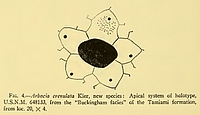
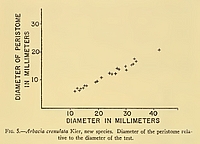
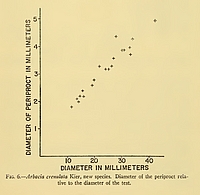
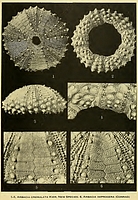
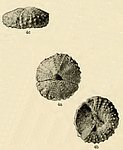

,%20apical,%20Pliocene%20moyen,%20Goose%20Creek%20Fauna,%20Berkeley%20Quarry,%20South%20Carolina,.jpg)
,%20oral,%20Pliocene%20moyen,%20Goose%20Creek%20Fauna,%20Berkeley%20Quarry,%20South%20Carolina,.jpg)

%20apical%20Pliocene%20Yorktown%20formation%20Charlotte%20Caroline%20du%20Sud%20USA%2033%20mm.jpg)
%20ambital%20Pliocene%20Yorktown%20formation%20Charlotte%20Caroline%20du%20Sud%20USA%2033%20mm.jpg)
%20oral%20Pliocene%20Yorktown%20formation%20Charlotte%20Caroline%20du%20Sud%20USA%2033%20mm.jpg)
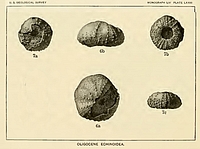
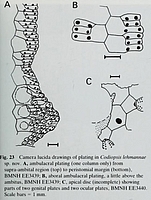

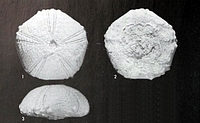

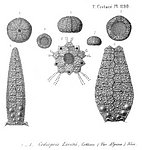
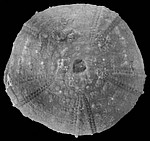

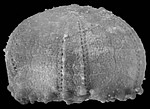
,%20apical,%20Aptien,%20Morella,%20Castellon,%20Espagne,%2046%20mm.jpg)
,%20amb2,%20Aptien,%20Morella,%20Castellon,%20Espagne,%2046%20mm.jpg)
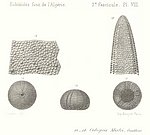
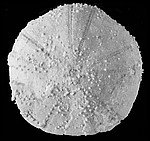
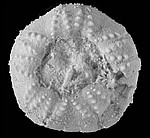

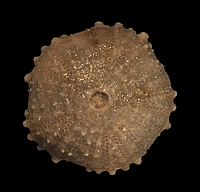
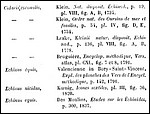
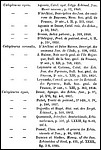

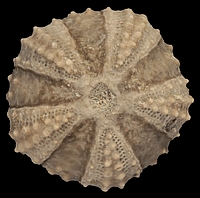
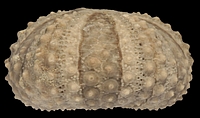
,%20detail,%20%20juveniles%20avec%20radioles,%20Eocene,%20France,%20plaque%2089%20mm.jpg)
,%20interamb,%20Eocene,%20Arguis,%20Huesca,%20Espagne,%2017%20mm.jpg)
,%20oral,%20Eocene,%20Arguis,%20Huesca,%20Espagne,%2017%20mm.jpg)
,%20apical,%20Eocene,%20Arguis,%20Huesca,%20Espagne,%2029%20mm.jpg)
,%20interamb,%20Eocene,%20Arguis,%20Huesca,%20Espagne,%2029%20mm.jpg)
,%20oral,%20Eocene,%20Arguis,%20Huesca,%20Espagne,%2029%20mm.jpg)
,%20apical,%20Eocene,%20Arguis,%20Huesca,%20Espagne,%2027%20mm.jpg)
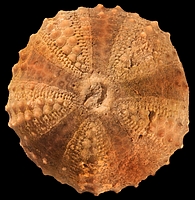
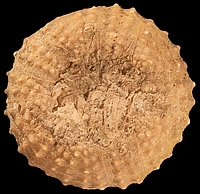
,%20apical,%20Eocène,%20Arguis,%20Huesca,%20Espagne,%2026%20mm.jpg)
,%20amb,Eocène,%20Arguis,%20Huesca,%20Espagne,%2026%20mm.jpg)
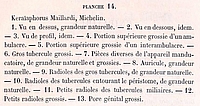
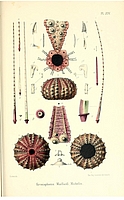

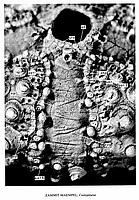
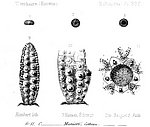


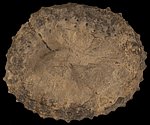
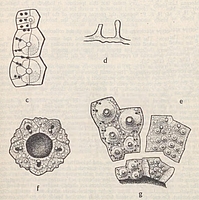

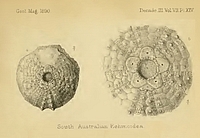
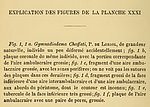
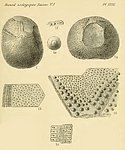
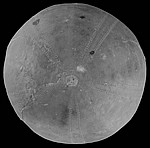
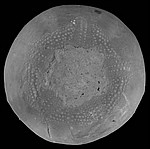
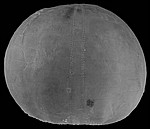
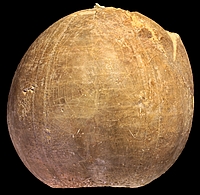
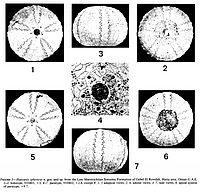
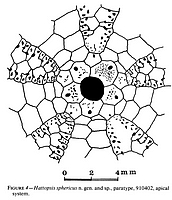
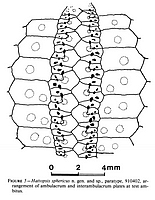
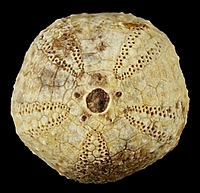
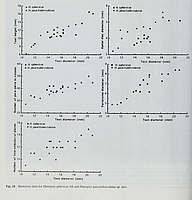
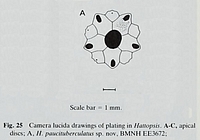
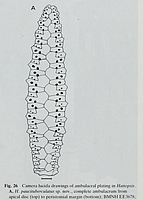


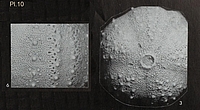
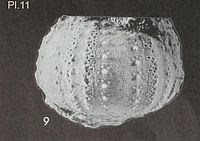
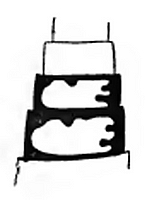

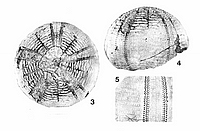
,%20Jebel%20Rawdah,%20Sultanate%20of%20Oman,%2076%20mm.jpg)